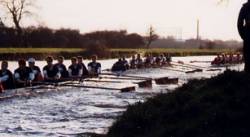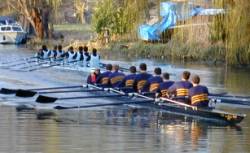Rowing at University in Cambridge
The Bumps
Introduction
 |
 |
 |
 |
 |
 |
Three crews converge - Jesus desparately try to bump Christ's before being hit by Emmanuel, Lents 2000 |
 |
 |
|
The Bumps are a historic form of racing between the college boat clubs, and run to a format dating back to the 1820s. It's a fantastically exciting one. Divisions of 17 or 18 crews line up along the river, with just one-and-a-half boat lengths (90 feet) between each. At the firing of a small cannon, all hell breaks loose as each crew tries to catch up with and actually collide with (bump) the crew in front before the crew behind does the same to them!
 |
 |
 |
 |
 |
 |
Our victorious Headship crew under pressure from Caius, Lents 2000 |
 |
 |
|
The races are held one each day for four days and by bumping on any given day, a crew moves up a place on the river for the following day's race. For any given crew, the aim is to go up four places on the river during the course of the four day's racing.
The starting order for the first day's racing is the finishing order of the previous year, and for each club the general aim is to perform consistently well over the years to develop and maintain high positions for its crews. The ultimate aim is to finish at the very top of the first division, i.e. Head of the River, or just Head. A crew which 'goes up' four or more, or finishes Head, wins their oars, or blades, and may have an oar decorated with the names of their crew's members and the boats that they bumped. Furthermore, it is has long been the tradition for the crew that finishes Head of the River to burn a boat in celebration!
 |
 |
 |
 |
 |
 |
The Boat Burning after the Lent Bumps 2000 |
 |
 |
It is the continuous racing year on year that makes the bumps quite so fascinating, and contributes to their aura of history and tradition. As a college oarsman you inherit a starting position thanks to the efforts of generation after generation of rowers before you, and your contribution to your boat's position is recorded not only in the twists and turns of that continuous line on the bumps chart, but by that boat's standing on the river for, in some cases, many years to come.
 |
 |
 |
 |
 |
 |
The Mays bumps chart - continuous racing from year to year |
 |
 |
Some clubs such as First and Third, LMBC and Jesus have a strong rowing tradition and have always been found near the top of the bumps and have highly placed lower crews. For new clubs or those without a tradition of strength, on the other hand, the process of climbing up divisions to be within striking distance of the Headship or lower boat headships would take 15 or 20 years even with consistently good results and phenomenal good luck. In practice, this makes the bumps perfect for exciting competition between clubs of different sizes and strengths; for example, First and Third and LMBC 3rd and 4th VIIIs fight for the honour of highest 3rd and 4th VIII respectively amongst 2nd VIIIs from smaller clubs - giving every crew a better chance of close races.
 |
 |
 |
 |
 |
 |
The 2002 4th May VIII, the highest 4th boat, won "spoons" by being bumped every day |
 |
 |
|
Whilst the Bumps are undoubtedly the most exciting rowing there is, they could never, however, be described as entirely fair or objective. To win coveted blades, crews often need some good luck as well as speed; it is not uncommon for good crews to be unrewarded due to the crews ahead 'bumping out', or for the racing to be disrupted by accidents or disputes. Furthermore, for clubs that have in recent years performed very well, crews already have high positions and often have their work cut out simply defending them - effort which, even if successful, goes without reward.
Finally, this format of racing, whilst arguably 'unfair' and dangerous, is of course very interesting and exciting to watch. Whether you want to see crashes and carnage, or good rowing, it is well worth going as a spectator and, especially in good weather, the bumps attract large crowds.
 |
 |
 |
 |
 |
 |
Crowds at Grassy Corner - Mays 2000 |
 |
 |
Next: The Bumps Course











